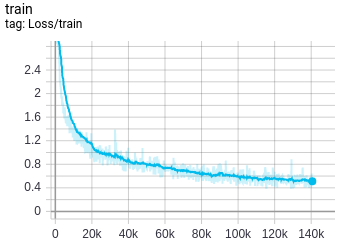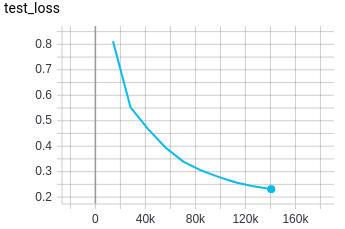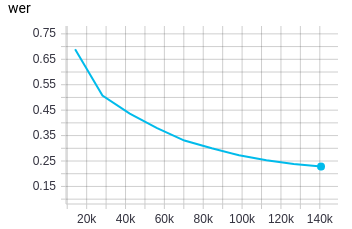End-to-end speech recognition model in PyTorch with DeepSpeech model
First, install dependencies
# clone project
git clone https://github.com/jiwidi/DeepSpeech-pytorch
# install project
cd DeepSpeech-pytorch
pip install -e .
pip install -r requirements.txtReady to run! execute:
python train.py #Will run with default parameters and donwload the datasets in the local directoryTensorboard logs will be saved under the runs/ folder
The model is a variation of DeepSpeech 2 from the guys at assemblyai
DeepSpeech(
(cnn): Conv2d(1, 32, kernel_size=(3, 3), stride=(2, 2), padding=(1, 1))
(rescnn_layers): Sequential(
(0): ResidualCNN(
(cnn1): Conv2d(32, 32, kernel_size=(3, 3), stride=(1, 1), padding=(1, 1))
(cnn2): Conv2d(32, 32, kernel_size=(3, 3), stride=(1, 1), padding=(1, 1))
(dropout1): Dropout(p=0.1, inplace=False)
(dropout2): Dropout(p=0.1, inplace=False)
(layer_norm1): CNNLayerNorm(
(layer_norm): LayerNorm((64,), eps=1e-05, elementwise_affine=True)
)
(layer_norm2): CNNLayerNorm(
(layer_norm): LayerNorm((64,), eps=1e-05, elementwise_affine=True)
)
)
(1): ResidualCNN(
(cnn1): Conv2d(32, 32, kernel_size=(3, 3), stride=(1, 1), padding=(1, 1))
(cnn2): Conv2d(32, 32, kernel_size=(3, 3), stride=(1, 1), padding=(1, 1))
(dropout1): Dropout(p=0.1, inplace=False)
(dropout2): Dropout(p=0.1, inplace=False)
(layer_norm1): CNNLayerNorm(
(layer_norm): LayerNorm((64,), eps=1e-05, elementwise_affine=True)
)
(layer_norm2): CNNLayerNorm(
(layer_norm): LayerNorm((64,), eps=1e-05, elementwise_affine=True)
)
)
)
(fully_connected): Linear(in_features=2048, out_features=512, bias=True)
(birnn_layers): Sequential(
(0): BidirectionalGRU(
(BiGRU): GRU(512, 512, batch_first=True, bidirectional=True)
(layer_norm): LayerNorm((512,), eps=1e-05, elementwise_affine=True)
(dropout): Dropout(p=0.1, inplace=False)
)
(1): BidirectionalGRU(
(BiGRU): GRU(1024, 512, bidirectional=True)
(layer_norm): LayerNorm((1024,), eps=1e-05, elementwise_affine=True)
(dropout): Dropout(p=0.1, inplace=False)
)
(2): BidirectionalGRU(
(BiGRU): GRU(1024, 512, bidirectional=True)
(layer_norm): LayerNorm((1024,), eps=1e-05, elementwise_affine=True)
(dropout): Dropout(p=0.1, inplace=False)
)
)
(classifier): Sequential(
(0): Linear(in_features=1024, out_features=512, bias=True)
(1): GELU()
(2): Dropout(p=0.1, inplace=False)
(3): Linear(in_features=512, out_features=29, bias=True)
)
)
Num Model Parameters 14233053With the following architecture:

Results of training for 10 epochs show a great potencial. I would like to spend more time finetuning the model and training for longer epochs but I need to purchase cloud computing for that and is out of my scope right now.
| Training data | Test data |
|---|---|
 |
 |
| Character error rate CER | Word error rate WER |
|---|---|
 |
 |
For testing the model we used the Librispeech dataset and performed a MelSpectogram followed by FrequencyMasking to mask out the frequency dimension, and TimeMasking for the time dimension.
train_audio_transforms = nn.Sequential(
torchaudio.transforms.MelSpectrogram(sample_rate=16000, n_mels=128),
torchaudio.transforms.FrequencyMasking(freq_mask_param=15),
torchaudio.transforms.TimeMasking(time_mask_param=35)
)